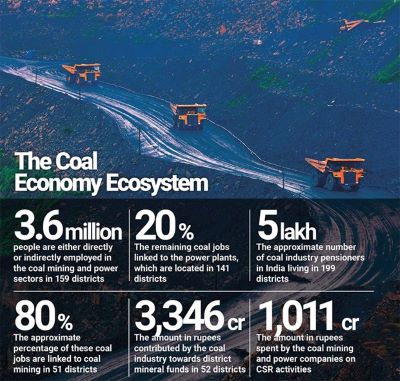Context: On July 13, three workers died of asphyxiation inside an illegal coal mine in Gujarat’s Surendranagar district. The officials said that the workers were working in a mine near Bhet village in Thangadh taluka without helmets, masks, or other safety equipment. The first information report (FIR) indicated that the accused failed to provide essential safety gear to the labourers, who died after inhaling toxic gas in the mine. The police have registered a case of culpable homicide not amounting to murder against four people.
Illegal Coal Mining and Legal Framework
Prevalence of Illegal Coal Mining
The Surendranagar incident highlights a broader issue: illegal coal mining is prevalent across India, with similar tragic events reported in other states. For instance, in June 2023, three people, including a child, were killed in Jharkhand when an illegal mine collapsed. In October 2023, a mine collapse in West Bengal led to at least three more fatalities. Such incidents are not uncommon and illustrate the severe consequences of illegal mining practices.
Legal Framework Governing Coal Mining
Coal mining in India is regulated under several laws and regulations. The Coal Mines (Nationalisation) Act, 1973, is the central legislation that governs eligibility for coal mining. The Act was introduced in two phases: first, for coking coal in 1971-72, and then for non-coking coal in 1973. According to the Constitution of India, the ownership of minerals within state boundaries is mandated to the state government under entry No. 23 of List II (State List). Conversely, entry No. 54 of List I (Central List) assigns ownership of minerals located within the exclusive economic zone (EEZ) of India to the central government. This framework is implemented through the Mines and Minerals (Development and Regulation) Act of 1957.
For mineral exploration and extraction in areas beyond national jurisdiction, the International Seabed Authority (ISA) oversees activities in the international seabed area. Guided by the United Nations treaty, the ISA regulates these activities, and as a signatory to the treaty, India has secured exclusive rights to explore polymetallic nodules over an area of 75,000 square kilometres in the Central Indian Ocean Basin. Despite these regulations, illegal mining remains a significant problem because it is treated as a law and order issue under State jurisdiction, shifting the responsibility for enforcement and control to State governments.
Why Illegal Coal Mining Persists?
Several factors contribute to the rampant nature of illegal coal mining in India:
● High Demand for Coal: Coal is important for meeting India’s energy needs, comprising 55% of the country’s energy supply. The high demand often exceeds legal supply, encouraging illegal mining operations.
● Economic Conditions: Many coal-rich areas are also among the most impoverished and underdeveloped, with high unemployment rates. This economic desperation drives local communities to engage in illegal mining to survive.
● Weak Regulations and Enforcement: In remote areas, mining regulations are poorly enforced due to limited monitoring and resources. This situation fosters the emergence of “coal mafias,” which operate with relative impunity. For instance, there have been allegations of political and police involvement in illegal mining operations.
● Political and Social Factors: In some areas, illegal mining allegedly receives tacit support from local political leaders, making it difficult to address effectively. Reports have indicated that political figures may be involved or complicit in illegal mining activities, complicating efforts to curb these operations.
● Rudimentary Techniques: Illegal mining often employs primitive methods like surface and rat-hole mining, which are less costly but highly dangerous. The lack of proper safety equipment and techniques significantly increases the risks for workers.
Safety Risks for Workers
Workers in illegal coal mines face severe safety hazards:
● Lack of Safety Equipment: The absence of helmets, masks, and other protective gear leads to increased respiratory risks and exposure to toxic gases. The Surendranagar incident, for example, involved fatalities from carbon monoxide poisoning due to inadequate safety measures.
● Hazardous Working Conditions: Illegal mines often lack proper structural support, making them prone to collapses, landslides, and explosions. Workers may also be exposed to high levels of toxic substances like lead and mercury, causing both acute poisoning and long-term health issues.
● Inadequate Training: Many workers are untrained in handling the risks associated with mining. This lack of training, coupled with the absence of emergency response facilities, exacerbates the danger.
● Exploitation: Workers in illegal mines are frequently exploited and face negligence from operators who prioritise profits over safety.

Challenges in Addressing Illegal Mining
Efforts to combat illegal coal mining face several obstacles:
● Jurisdictional Issues: Since illegal mining is a law and order issue, the responsibility primarily lies with State governments. The Union government often shifts the blame to State authorities, complicating efforts to address the problem comprehensively.
● Economic and Social Dependence: Local economies in many mining regions rely heavily on coal mining. When official mining operations end, illegal mining often continues to support local livelihoods.
● Complex Legal Framework: The intricate legal framework governing mining can result in bureaucratic inefficiencies, which may hinder effective enforcement and control.
Measures to Address Illegal Coal Mining
● Enhanced Coordination
To address illegal mining effectively, there must be improved collaboration between state governments and the Indian Bureau of Mines (IBM). This coordination is essential to ensure that actual mine production aligns with the approved mining plans. By synchronising efforts, both entities can better monitor mining activities and enforce regulations, thus preventing discrepancies and illegal operations.
● Investment in Measurement and Monitoring
Protecting minor minerals requires significant investment in production and consumption measurement tools. Additionally, robust monitoring and planning mechanisms must be developed to oversee these minerals effectively. Investment in these areas is crucial to track extraction volumes accurately and ensure that mining activities comply with legal standards.
● Technological Integration
The integration of advanced technologies can significantly enhance monitoring efforts. Satellite imagery should be utilized to track extraction volumes and assess mining processes. Moreover, employing drones, the Internet of Things (IoT), and blockchain technology can further improve monitoring mechanisms. These technologies, including Global Positioning Systems (GPS), radar, and Radio Frequency (RF) locators, provide precise and real-time data on mining activities.
● Proper Mine Closure
Effective management of closed mines is crucial to prevent illegal mining activities. Governments must ensure proper closure and security measures for all decommissioned mines. This includes requiring mining companies to submit mine closure plans and financial guarantees before permits are issued. Proper planning and security measures help mitigate the risk of illegal activities taking place in abandoned mining sites.
Conclusion
The illegal coal mining problem in India is marked by numerous incidents of worker fatalities, driven by high demand for coal, poverty, weak regulations, and alleged political support. Addressing this issue requires a multifaceted approach that includes strengthening regulations, improving enforcement, and addressing the socio-economic factors that drive illegal mining. Ensuring worker safety and tackling illegal mining effectively remain critical challenges for both State and Union governments. Further, India has made significant strides in technological advancements, particularly in remote monitoring and surveillance within the mining sector. Leveraging these technological advancements is a practical approach to effectively oversee and regulate mining activities across the country.
|
Probable Questions for UPSC Mains 1. Discuss the factors contributing to the persistence of illegal coal mining in India and evaluate the effectiveness of the existing legal and regulatory framework in addressing this issue. How can technological advancements aid in improving the oversight and regulation of mining activities? (10 Marks, 150 Words) 2. Analyse the impact of illegal coal mining on worker safety and the environment in India. What measures can be implemented to enhance the safety of workers and curb illegal mining practices, considering the roles of both state and central governments? (15 Marks, 250 Words) |
Source: The Hindu







